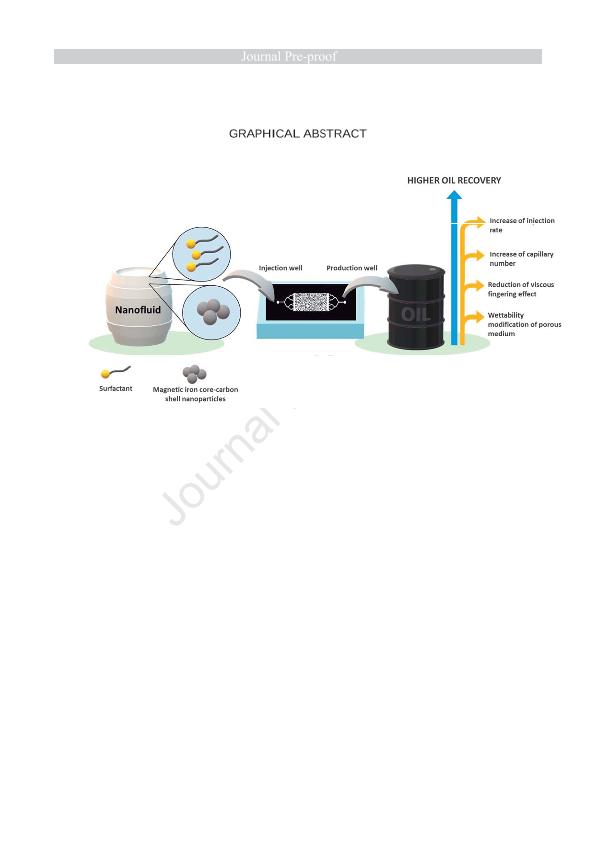Mostrar el registro sencillo del ítem
dc.contributor.author
Betancur, Stefanía
dc.contributor.author
Olmos Carreno, Carol Maritza

dc.contributor.author
Perez, Maximiliano Sebastian

dc.contributor.author
Lerner, Betiana

dc.contributor.author
Franco, Camilo A.
dc.contributor.author
Riazi, Masoud
dc.contributor.author
Gallego, Jaime

dc.contributor.author
Carrasco Marín, Francisco
dc.contributor.author
Cortés, Farid B.
dc.date.available
2022-02-08T02:41:29Z
dc.date.issued
2019-10
dc.identifier.citation
Betancur, Stefanía; Olmos Carreno, Carol Maritza; Perez, Maximiliano Sebastian; Lerner, Betiana; Franco, Camilo A.; et al.; A microfluidic study to investigate the effect of magnetic iron core-carbon shell nanoparticles on displacement mechanisms of crude oil for chemical enhanced oil recovery; Elsevier Science; Journal of Petroleum Science and Engineering; 184; 106589; 10-2019; 1-45
dc.identifier.issn
0920-4105
dc.identifier.uri
http://hdl.handle.net/11336/151524
dc.description.abstract
The main objective of this work is to evaluate the effect of the simultaneous use of a surfactant mixture and magnetic iron core-carbon shell nanoparticles on oil recovery via a microfluidic study based on the rock-on-a-chip technology. The surfactant solution used for all experiments was prepared based on a field formulation and consisted of a mixture of a hydrophilic and a lipophilic surfactant. Magnetic iron core-carbon shell nanoparticles with a mean particle size of 60 nm and a surface area of 123 m2 g−1 were employed. The displacement experiments consisted of waterflooding, surfactant flooding and nanoparticle-surfactant flooding and were performed using PDMS (polydimethylsiloxane)-glass microdevices type random network. The characteristics and design of the microfluidic device allowed to emulate a mixed wettability of a porous medium. Then, the oil was displaced by injecting the solution at a constant injection rate, until steady-state conditions were obtained. Furthermore, the effect of three injection rates corresponding to 0.1 ft day−1, 1 ft day−1, and 10 ft day−1 was investigated. The increase in the injection rate favored the oil recovery percentage. In addition, for all injection rates, the oil recovery decreased in the following order: nanoparticle-surfactant flooding > surfactant flooding > waterflooding. The nanoparticle-surfactant system at the injection rate of 1.9 μL min−1 presented the highest oil recovery (i.e., 84%). Likewise, nanoparticle-surfactant flooding showed a more stable displacement front and consequently, the highest capillary number among the injection fluids. Oil recovery by waterflooding was the lowest among the evaluated systems due to the viscous fingering phenomena under different injection rates. In addition, it can be observed that for all injection rates, the presence of the surfactant mixture and nanoparticles reduce the viscous fingering effect. The results can be used to visually and quantitatively analyze the role of the simultaneous use of nanoparticles with surfactants in enhanced oil recovery processes.
dc.format
application/pdf
dc.language.iso
eng
dc.publisher
Elsevier Science

dc.rights
info:eu-repo/semantics/openAccess
dc.rights.uri
https://creativecommons.org/licenses/by-nc-sa/2.5/ar/
dc.subject
MICROFLUIDIC
dc.subject
ENHANCED OIL RECOVERY
dc.subject
NANOPARTICLES
dc.subject
SURFACTANT
dc.subject.classification
Otras Nanotecnología

dc.subject.classification
Nanotecnología

dc.subject.classification
INGENIERÍAS Y TECNOLOGÍAS

dc.title
A microfluidic study to investigate the effect of magnetic iron core-carbon shell nanoparticles on displacement mechanisms of crude oil for chemical enhanced oil recovery
dc.type
info:eu-repo/semantics/article
dc.type
info:ar-repo/semantics/artículo
dc.type
info:eu-repo/semantics/publishedVersion
dc.date.updated
2022-01-25T15:07:30Z
dc.journal.volume
184
dc.journal.number
106589
dc.journal.pagination
1-45
dc.journal.pais
Países Bajos

dc.journal.ciudad
Amsterdam
dc.description.fil
Fil: Betancur, Stefanía. Universidad Nacional de Colombia. Sede Medellín; Colombia. Universidad de Granada; España
dc.description.fil
Fil: Olmos Carreno, Carol Maritza. Consejo Nacional de Investigaciones Científicas y Técnicas; Argentina. Universidad Nacional de Colombia. Sede Medellín; Colombia. Universidad Tecnológica Nacional. Facultad Regional Haedo; Argentina
dc.description.fil
Fil: Perez, Maximiliano Sebastian. Universidad Tecnológica Nacional. Facultad Regional Haedo; Argentina. Consejo Nacional de Investigaciones Científicas y Técnicas; Argentina. Universidad de Buenos Aires; Argentina
dc.description.fil
Fil: Lerner, Betiana. Universidad Tecnológica Nacional. Facultad Regional Haedo; Argentina. Consejo Nacional de Investigaciones Científicas y Técnicas; Argentina. Universidad de Buenos Aires; Argentina
dc.description.fil
Fil: Franco, Camilo A.. Universidad Nacional de Colombia. Sede Medellin; Colombia
dc.description.fil
Fil: Riazi, Masoud. Shiraz University; Irán
dc.description.fil
Fil: Gallego, Jaime. Universidad Nacional de Colombia. Sede Medellin; Colombia. Universidad de Antioquia; Colombia
dc.description.fil
Fil: Carrasco Marín, Francisco. Universidad de Granada; España
dc.description.fil
Fil: Cortés, Farid B.. Universidad Nacional de Colombia. Sede Medellin; Colombia
dc.journal.title
Journal of Petroleum Science and Engineering

dc.relation.alternativeid
info:eu-repo/semantics/altIdentifier/doi/http://dx.doi.org/10.1016/j.petrol.2019.106589
dc.relation.alternativeid
info:eu-repo/semantics/altIdentifier/url/https://www.sciencedirect.com/science/article/abs/pii/S0920410519310101
Archivos asociados
